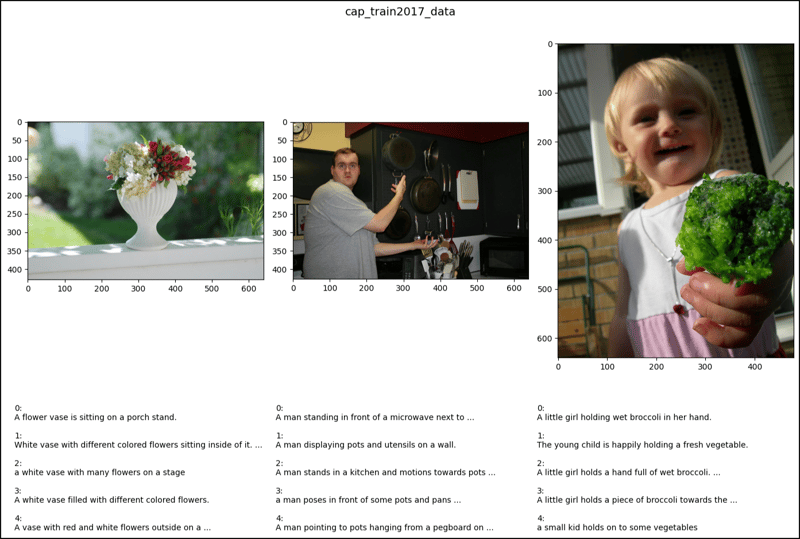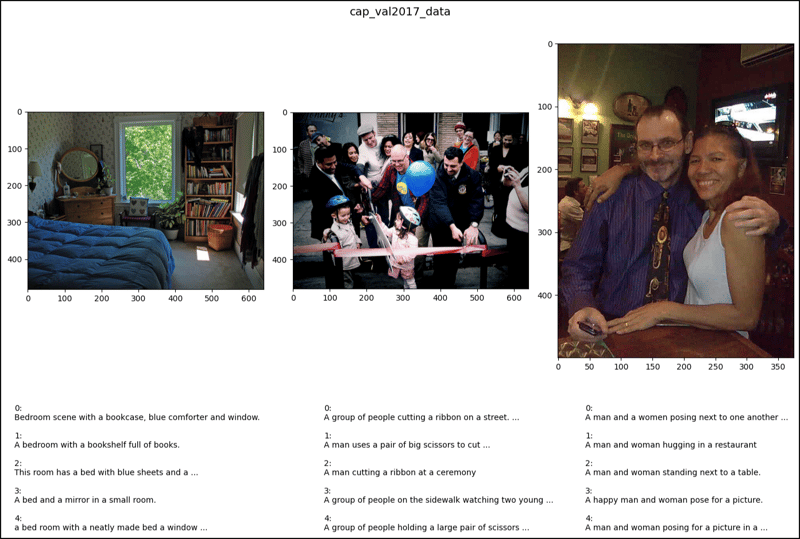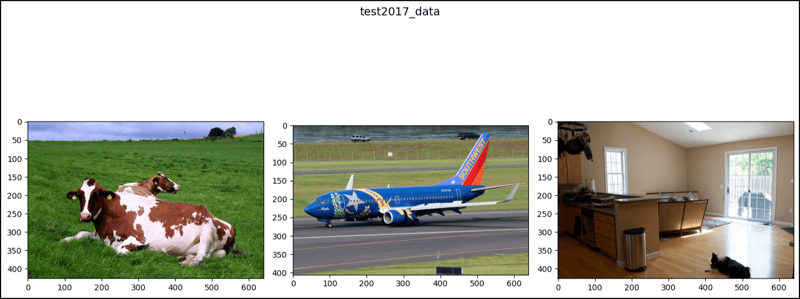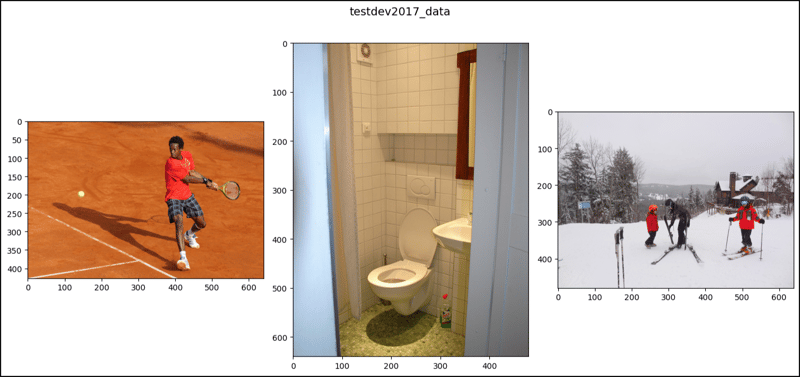CocoCaptions in PyTorch (2)
This post demonstrates using the MS COCO dataset with torchvision.datasets.CocoCaptions and torchvision.datasets.CocoDetection. We'll explore loading data for image captioning and object detection tasks using various subsets of the dataset.
The examples below utilize different COCO annotation files (captions_*.json, instances_*.json, person_keypoints_*.json, stuff_*.json, panoptic_*.json, image_info_*.json) along with the corresponding image directories (train2017, val2017, test2017). Note that CocoDetection handles different annotation types, while CocoCaptions primarily focuses on captions.
CocoCaptions Example:
This section shows how to load caption data from train2017, val2017, and test2017 using CocoCaptions. It highlights that only the caption annotations are accessed; attempts to access instance or keypoint data result in errors.
from torchvision.datasets import CocoCaptions
import matplotlib.pyplot as plt
# ... (Code to load CocoCaptions datasets as shown in the original post) ...
# Function to display images and captions (modified for clarity)
def show_images(data, ims):
fig, axes = plt.subplots(nrows=1, ncols=len(ims), figsize=(14, 8))
for i, ax, im_index in zip(range(len(ims)), axes.ravel(), ims):
image, captions = data[im_index]
ax.imshow(image)
ax.axis('off') # Remove axis ticks and labels
for j, caption in enumerate(captions):
ax.text(0, j * 15, f"{j+1}: {caption}", fontsize=8, color='white') #add caption
plt.tight_layout()
plt.show()
ims = [2, 47, 64] #indices for images to display
show_images(cap_train2017_data, ims)
show_images(cap_val2017_data, ims)
show_images(test2017_data, ims) #test2017 only has image info, no captions
show_images(testdev2017_data, ims) #test-dev2017 only has image info, no captions




CocoDetection Example (Illustrative):
The original post shows examples of loading CocoDetection with various annotation types. Remember that error handling would be necessary for production code to manage cases where annotations are missing or improperly formatted. The core concept is to load the dataset using different annotation files depending on the desired task (e.g., object detection, keypoint detection, stuff segmentation). The code would be very similar to the CocoCaptions example, but using CocoDetection and handling different annotation structures accordingly. Because showing the output would be extremely long and complex, it's omitted here.
This revised response provides a more concise and clearer explanation of the code and its functionality, focusing on the key aspects and addressing potential errors. It also improves the image display function for better readability.
The above is the detailed content of CocoCaptions in PyTorch (2). For more information, please follow other related articles on the PHP Chinese website!

Hot AI Tools

Undresser.AI Undress
AI-powered app for creating realistic nude photos

AI Clothes Remover
Online AI tool for removing clothes from photos.

Undress AI Tool
Undress images for free

Clothoff.io
AI clothes remover

Video Face Swap
Swap faces in any video effortlessly with our completely free AI face swap tool!

Hot Article

Hot Tools

Notepad++7.3.1
Easy-to-use and free code editor

SublimeText3 Chinese version
Chinese version, very easy to use

Zend Studio 13.0.1
Powerful PHP integrated development environment

Dreamweaver CS6
Visual web development tools

SublimeText3 Mac version
God-level code editing software (SublimeText3)

Hot Topics
 1655
1655
 14
14
 1413
1413
 52
52
 1306
1306
 25
25
 1252
1252
 29
29
 1225
1225
 24
24
 Python vs. C : Applications and Use Cases Compared
Apr 12, 2025 am 12:01 AM
Python vs. C : Applications and Use Cases Compared
Apr 12, 2025 am 12:01 AM
Python is suitable for data science, web development and automation tasks, while C is suitable for system programming, game development and embedded systems. Python is known for its simplicity and powerful ecosystem, while C is known for its high performance and underlying control capabilities.
 Python: Games, GUIs, and More
Apr 13, 2025 am 12:14 AM
Python: Games, GUIs, and More
Apr 13, 2025 am 12:14 AM
Python excels in gaming and GUI development. 1) Game development uses Pygame, providing drawing, audio and other functions, which are suitable for creating 2D games. 2) GUI development can choose Tkinter or PyQt. Tkinter is simple and easy to use, PyQt has rich functions and is suitable for professional development.
 How Much Python Can You Learn in 2 Hours?
Apr 09, 2025 pm 04:33 PM
How Much Python Can You Learn in 2 Hours?
Apr 09, 2025 pm 04:33 PM
You can learn the basics of Python within two hours. 1. Learn variables and data types, 2. Master control structures such as if statements and loops, 3. Understand the definition and use of functions. These will help you start writing simple Python programs.
 The 2-Hour Python Plan: A Realistic Approach
Apr 11, 2025 am 12:04 AM
The 2-Hour Python Plan: A Realistic Approach
Apr 11, 2025 am 12:04 AM
You can learn basic programming concepts and skills of Python within 2 hours. 1. Learn variables and data types, 2. Master control flow (conditional statements and loops), 3. Understand the definition and use of functions, 4. Quickly get started with Python programming through simple examples and code snippets.
 Python vs. C : Learning Curves and Ease of Use
Apr 19, 2025 am 12:20 AM
Python vs. C : Learning Curves and Ease of Use
Apr 19, 2025 am 12:20 AM
Python is easier to learn and use, while C is more powerful but complex. 1. Python syntax is concise and suitable for beginners. Dynamic typing and automatic memory management make it easy to use, but may cause runtime errors. 2.C provides low-level control and advanced features, suitable for high-performance applications, but has a high learning threshold and requires manual memory and type safety management.
 Python: Exploring Its Primary Applications
Apr 10, 2025 am 09:41 AM
Python: Exploring Its Primary Applications
Apr 10, 2025 am 09:41 AM
Python is widely used in the fields of web development, data science, machine learning, automation and scripting. 1) In web development, Django and Flask frameworks simplify the development process. 2) In the fields of data science and machine learning, NumPy, Pandas, Scikit-learn and TensorFlow libraries provide strong support. 3) In terms of automation and scripting, Python is suitable for tasks such as automated testing and system management.
 Python and Time: Making the Most of Your Study Time
Apr 14, 2025 am 12:02 AM
Python and Time: Making the Most of Your Study Time
Apr 14, 2025 am 12:02 AM
To maximize the efficiency of learning Python in a limited time, you can use Python's datetime, time, and schedule modules. 1. The datetime module is used to record and plan learning time. 2. The time module helps to set study and rest time. 3. The schedule module automatically arranges weekly learning tasks.
 Python: Automation, Scripting, and Task Management
Apr 16, 2025 am 12:14 AM
Python: Automation, Scripting, and Task Management
Apr 16, 2025 am 12:14 AM
Python excels in automation, scripting, and task management. 1) Automation: File backup is realized through standard libraries such as os and shutil. 2) Script writing: Use the psutil library to monitor system resources. 3) Task management: Use the schedule library to schedule tasks. Python's ease of use and rich library support makes it the preferred tool in these areas.




